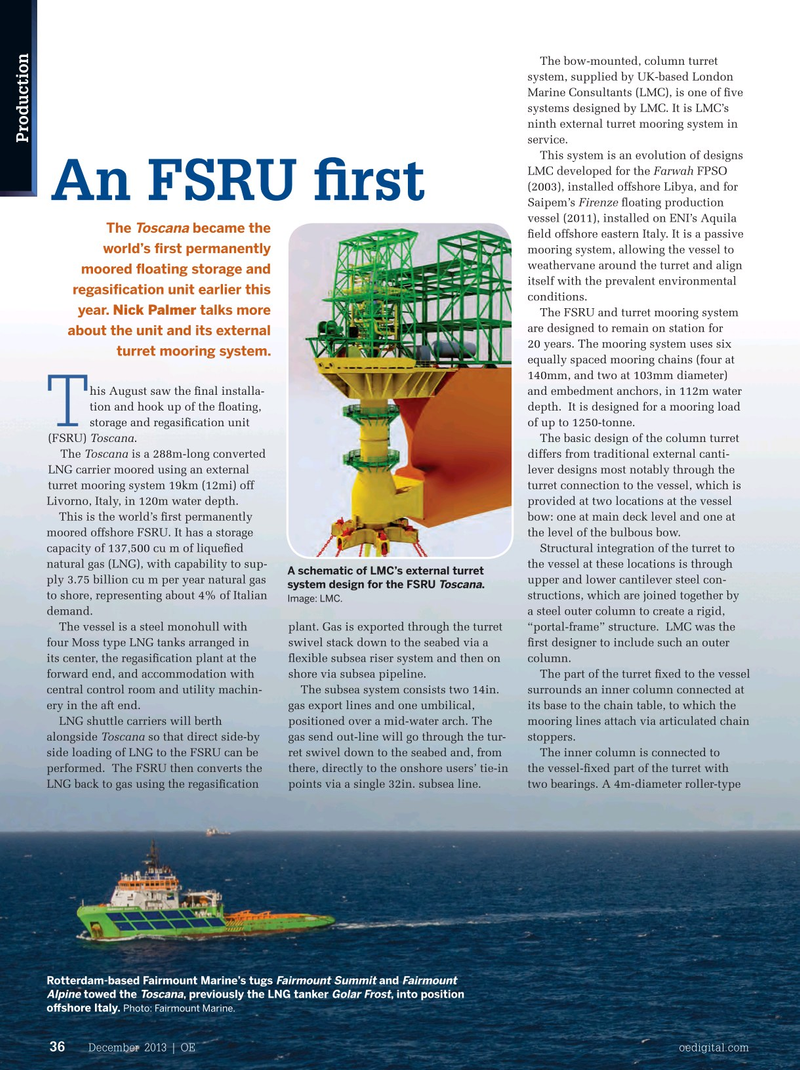
Page 34: of Offshore Engineer Magazine (Dec/Jan 2013)
Read this page in Pdf, Flash or Html5 edition of Dec/Jan 2013 Offshore Engineer Magazine
The bow-mounted, column turret system, supplied by UK-based London
Marine Consultants (LMC), is one of fve systems designed by LMC. It is LMC’s ninth external turret mooring system in
Production service.
This system is an evolution of designs
LMC developed for the Farwah FPSO (2003), installed offshore Libya, and for
An FSRU frst
Saipem’s Firenze foating production vessel (2011), installed on ENI’s Aquila
The became the Toscana feld offshore eastern Italy. It is a passive world’s frst permanently mooring system, allowing the vessel to weathervane around the turret and align moored foating storage and itself with the prevalent environmental regasifcation unit earlier this conditions. year. Nick Palmer talks more
The FSRU and turret mooring system are designed to remain on station for about the unit and its external 20 years. The mooring system uses six turret mooring system.
equally spaced mooring chains (four at 140mm, and two at 103mm diameter) his August saw the fnal installa- and embedment anchors, in 112m water tion and hook up of the foating, depth. It is designed for a mooring load
T storage and regasifcation unit of up to 1250-tonne.
(FSRU) Toscana. The basic design of the column turret
The Toscana is a 288m-long converted differs from traditional external canti-
LNG carrier moored using an external lever designs most notably through the turret mooring system 19km (12mi) off turret connection to the vessel, which is
Livorno, Italy, in 120m water depth. provided at two locations at the vessel
This is the world’s frst permanently bow: one at main deck level and one at moored offshore FSRU. It has a storage the level of the bulbous bow. capacity of 137,500 cu m of liquefed Structural integration of the turret to natural gas (LNG), with capability to sup- the vessel at these locations is through
A schematic of LMC’s external turret ply 3.75 billion cu m per year natural gas upper and lower cantilever steel con- system design for the FSRU . Toscana to shore, representing about 4% of Italian structions, which are joined together by
Image: LMC.
demand. a steel outer column to create a rigid,
The vessel is a steel monohull with plant. Gas is exported through the turret “portal-frame” structure. LMC was the four Moss type LNG tanks arranged in swivel stack down to the seabed via a frst designer to include such an outer its center, the regasifcation plant at the fexible subsea riser system and then on column.
forward end, and accommodation with shore via subsea pipeline. The part of the turret fxed to the vessel central control room and utility machin- The subsea system consists two 14in. surrounds an inner column connected at ery in the aft end. gas export lines and one umbilical, its base to the chain table, to which the
LNG shuttle carriers will berth positioned over a mid-water arch. The mooring lines attach via articulated chain alongside Toscana so that direct side-by gas send out-line will go through the tur- stoppers.
side loading of LNG to the FSRU can be ret swivel down to the seabed and, from The inner column is connected to performed. The FSRU then converts the there, directly to the onshore users’ tie-in the vessel-fxed part of the turret with
LNG back to gas using the regasifcation points via a single 32in. subsea line. two bearings. A 4m-diameter roller-type
Rotterdam-based Fairmount Marine’s tugs and Fairmount Summit Fairmount
Alpine Toscana Golar Frost towed the , previously the LNG tanker , into position ofshore Italy. Photo: Fairmount Marine.
December 2013 | OE oedigital.com 36 036_OE1213_ProdOps1-london marine.indd 36 11/22/13 6:22 PM

 33
33

 35
35